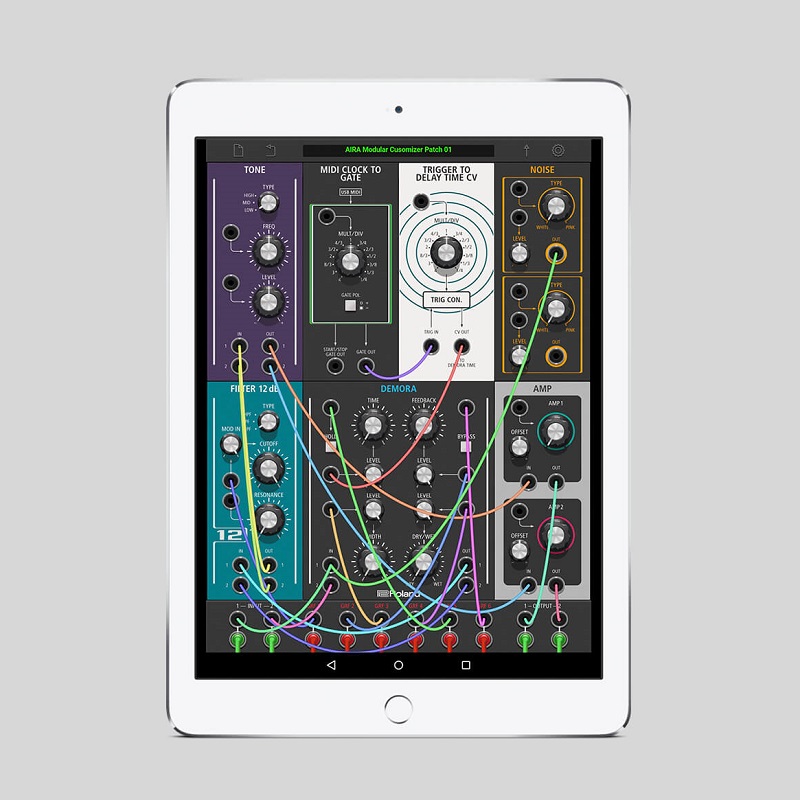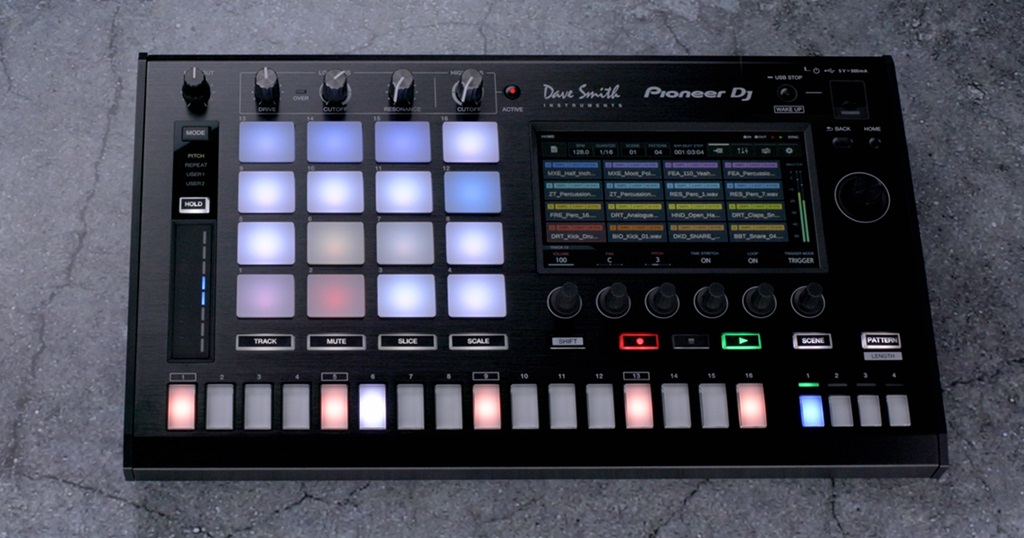
INSIDE THE AIRA MODULAR CUSTOMIZER
April 25, 2016The AIRA Modular Customizer brings a whole virtual modular synthesizer to your AIRA Modular EFX module. This article explains more about the “synth behind the synth” available for the new BITRAZER, DEMORA, TORCIDOand SCOOPER modules.
Originally published by Christian Moraga for the Roland Australia Blog
If you are a fan of electronic music, you would have noticed the recent emergence of a new instrument gracing the stage, and studios, of your favourite producers. The instrument, packed with knobs, switches and a mess of wires is a modular synthesizer – and it is experiencing a renaissance from the early days of synthesizers.
Roland have recently re-entered the world of modular synthesis: extending on from the legacy Roland SYSTEM-100m and SYSTEM-700 modular synths of the past. Four of the new modules are part of the Roland AIRA Modular EFX product range. These effect modules (below) will take your synthesizer sounds to a whole other level by sync’ing to your existing control voltage (CV) gear, other AIRA instruments and AIRA EFX modules. The modules are:
AIRA MODULAR CUSTOMIZER
It may not look like it from the front panel, but each one of the AIRA EFX module has a modular synthesizer inside… virtually of course. There are 15 sub-modules to choose from that fully re-program the internal signal path of the AIRA EFX, save the patch and recall it in real-time.
Yes, you can save patches on your modular synthesizer and take those same sounds from studio to stage with a press of a button!
This is the future of modular. Are you ready to take a closer look?
The AIRA Modular Customizer has six slots available per patch. These can be any combination of the 15 sub-modules below. Simply drop a module in place, and drag a virtual wire from output to input to create anything from a subtle modulation patch to a complex, cross-modulating feedback patch. Each patch you create is part experimentation, part knowledge, and a whole lot of fun.
This is what makes modular synthesis so exciting… you have instant access to an infinite world of sounds at the end of a handful of cables.
With the AIRA Modular Customizer, your modular synth setup just got a whole lot bigger with LFOs, ADSRs, noise sources, VCAs, mixers, and more – all under-the-hood of your AIRA EFX.
Let’s learn more about each sub-module in the next section.
WHAT ARE THE SUB-MODULES?
 Each sub-module below have a coloured line (red, blue or green) to designate whether it can control other modules, output audio or both. Use this as a reference when making your own custom patches.
Each sub-module below have a coloured line (red, blue or green) to designate whether it can control other modules, output audio or both. Use this as a reference when making your own custom patches.
ADSR
Every musical sound you hear has a “shape” in its loudness; a trumpet blast has a different shape than a bowed violin string. In synthesis, this shape is an envelope, or more specifically an ADSR (Attack/Decay/Sustain/Release, click here for more info on envelopes).
Envelopes can control frequency (pitch), timbre (filter), loudness (amplitude) and much more. You will need a gate signal to start the envelope phase.
AMP
The amp module controls the level of an incoming audio, or CV signal. Uses for the amp module include tremolo like volume effects, string swell attack or panning effects to name a few. You will need an input signal and a control voltage source (LFO, ADSR etc.)
CURVE CONVERTER
This module converts an input signal to one of six curve shapes, and its inverse shape. This is useful for turning gates into pitch risers, or re-trigger the CV Input for unique curved envelopes for creative modulation options.
FILTER 6dB/12dB
There are two stereo multi-mode filters available with -6dB and -12dB attenuation. Each filter has low-pass, high-pass and band-pass options with CV control over CUTOFF and RESONANCE. Use a filter before the output for darker DEMORA delay tones or crank the resonance to take your signal to the edge of feedback.
GATE DIVIDER
This module takes your trigger signal from a clock source, and converts it to a gate signal for either a multiple or divided tempo. This is iseful to keep all of your triggered envelopes/LFOs tempo-matched. Using multiples and divisions are great for creating polyrhythmic patterns or introducing “randomness” to your patches.
LOW FREQUENCY OSCILLATOR (LFO)
Oscillators can not only generate audio signals at high frequency but can also be used as a control signal at low frequencies (a 0.01Hz LFO requires ten seconds to complete on full cycle). The LFO has six waveshapes with the ability to blend between each, and can be used to gate on/off (square wave), add weeps (sine wave) or randomise pitch or filter cutoff (stepped/random wave).
MIDI CLOCK TO GATE
This module is useful for converting the incoming MIDI clock, say from an SBX-1, and outputs a start/stop gate (useful for sequencers) and a gate output with multiple/divisions like the GATE TRIGGER module.
MIXER – MONO/STEREO
There are fewer modules more important in a modular system than a mixer. As your system builds, you will need a way to control how to combine these signals – whether it is audio signals or control voltage signals. Blending CV signals can produce complex modulation sources (an LFO with an envelope for example) or combine multiple filter outputs for an array of resonant tones.
A stereo mixer allows for the control of the blended signals in the stereo field to enhance effects such as the DEMORA delay or loops from the SCOOPER.
NOISE GENERATOR
Unlike oscillators that output a specific frequency or pitch, a noise generator outputs a random combination of all frequencies. This sound source is typically used as a wind sound, surf sound effect and is the module you will use when creating a percussive sound, like a cymbal. Different filtered noise sounds are provided in this module as white and pink and anywhere in between.
If you are feeling adventurous, try modulating another module using noise through the AMP module.
RING MODULATOR
The “Ring Mod” is one of the most unique sounds in a synthesizer and was made famous by the Daleks, for all the Doctor Who fans. A Ring Modulator combines two signals and multiplies them. The output results in a combination of harmonics (sum and difference of the input frequencies) that drown out the fundamental. Sweeping the frequencies of each input signal will give a range of metallic, bell-like tones that are synonymous with ring modulators.
SAMPLE & HOLD
The Sample & Hold module is another module found in the classic modular synthesizers of the past. You might be familiar with the “bleep-bloop” sounds heard in 60’s sci-fi film soundtracks… this is the S&H at work. The Sample & Hold module is great for introducing random and repeating patterns to your synthesizer signal. Understanding how the S&H operates will help you utilise this powerful module in your patches,
To get started. you will need an input signal and a clock source. The input signal will be sampled at regular intervals and sent through to the output. The intervals of sampling is determined by a clock pulse, trigger input (from a keyboard press for example) or the modules in-built clock source.
To create a random pattern for modulating pitch, filter cutoff etc., you will need to input a NOISE GENERATOR. Noise sources output a random combination of ALL frequencies – ideal for sampling for random modulations. With the AIRA Modular Customizer S&H, try adding two different input sources at the same time. The more frequencies available for sampling, the more random your modulation source.
TONE
This module allows for equalisation compensation across three-bands: low range, mid-range or high range. FREQ selects the center frequency and you can cut and boost with the LEVEL knob (both being able to be controlled via CV). Use the Tone module to boost bass response in your percussion tracks, or brighten up the top end of your lead synth lines.
TRIGGER TO DELAY TIME CV
Designed specifically for the DEMORA module, it converts a clock/trigger signal to multiples and divisions to be uses to control DEMORA DELAY TIME. This module ensures your external clock signals are in sync with your delay time (such as tap tempo).

SIXTEEN NEW SUB-MODULES IN VERSION 1.5
Version 1.5 of the AIRA Modular Customizer brings with sixteen new sub-modules that takes the BITRAZER,DEMORA, TORCIDO and SCOOPER beyond effector modules.
Below are the descriptions of the powerful new sub-modules that transform the AIRA Effectors into a powerful standalone synthesizer!
SHORT DELAY
This module provides any patch with a short delay (up to 80ms) that can be used for slapback echo or chorus/flange effects when the DELAY TIME is modulated with and LFO.
TUBE CLIP
Add some “warmth” to your patch by using the TUBE CLIP sub-module. this module emulates the soft clipping sound of valve overdrive with the boosted even-order harmonics providing a classic distortion sound when gain is at maximum.
COMPRESSOR
This dynamic effect module can help maintain level/gain consistency in your patch – especially when using a resonant filter. Modulating the THRESHOLD control with an envelope can create side-chain compression effects.
NOISE GATE
Unlike the COMPRESSOR module which attenuates the signal above the threshold, the NOISE GATE attenuates signals below the threshold. This is very useful in reducing the noise in processed signals for a cleaner output.
3 BAND EQ
This active equalizer module allows you to process the low, middle and high frequency bands of your patch. You can either boost or cut at each band and is useful for adding extra bass to a kick, or more presence to your lead synth line.
LOGIC OPERATION
This module takes two input signals and outputs a choice of one depending on one of eight mathematical operations. This is great for creating rhythmic patterns by combining two clock signals, or to add some variations to a sequencer pattern by combing gate signals. Experiment with CV signals – even audio rate signals and take a walk on the harsh side!
CROSS FADE
This module lets you morph between two audio or CV signals – great for slow transitions or create dynamic pulses between two waveforms for example. The rate of morphing can be done manually with the CROSS FADE knob or via control voltage.
SWITCHER
Similar to the CROSS FADE module, the switcher takes two input signals and instantaneously switches between them with an incoming trigger signal. A gate signal is also output from the module as well as the switched signal.
ENVELOPER
An envelope follower is a module that takes an input signal with a unique dynamic curve, and outputs an envelope signal with RELEASE and OUTPUT level used to control the shape/amplitude. A drum sequence can be input to gate a synthesizer patch or use a kick drum signal to create an envelope to control a compressor/cross fade module.
TRIGGER TO LFO RATE CV
This module allows you to sync your LFO sub-module with an external trigger input in order to keep your modulations in time with either an internal or external clock signal. You could also connect a GRF switch to the TRIG IN to create a tap-tempo LFO. This module outputs a multiple or division of the incoming trigger rate.
FILTER -18dB AND -24 dB
These two modules join the -6dB and -12dB filter modules from version 1.0. These two additional filter modules provide you with more options of cutoff attenuation in low-pass, high-pass and band-pass types.
FORMANT FILTER
This module splits the input signal and runs it through two independent formant circuits. A formant is the name given to a vowel-like sound and you are able to choose two unique sounds and control its mix via the BALANCE control.
OSCILLATORS – SAW AND SQUARE
These two modules allow you to input CV and GATE signals into your AIRA Effector and create a tone-generating synthesizer in a module. Use an oscillator for a bass or lead sound or use multiple and create a detuned tone using the FINE control. The high tuning range of ‘ to 64’ make these a very flexible addition to your virtual modular rig.
MIDI NOTE TO CV
When connecting the AIRA Effector to the AIRA Modular Customizer, the MIDI input/output allow for the module to receive MIDI not-on/off messages from your DAW or other MIDI-output application. This module then converts this MIDI note information into 1V/OCTAVE and GATE signals that can then either, (a) control the internal SAW/SQUARE OSCILLATOR modules via virtual patching, or (b) control external synthesizers that take CV/GATE signals.
The ability to modulate the OCTAVE range switch and TRANSPOSITION allows for creative variations within a patch.
WHAT IS “GRF”?
The GRIFFER, or GRF, knobs lets you control the parameters of the pre-assigned sub-modules with high-resolution adjustments (24-bit knobs with over 16 million steps of resolution).
For example, if you aren’t using the BIT DOWN control on the BITRAZER but you have a FILTER 6dB in your sub-modular patch, you can assign “GRF 3” to the filter CUTOFF, or any other knob in your sub-modular patch.
By inputting a CV/GATE signal, the settings of the GRIFFER (GRF) knobs are added to the CV/GATE signal. The indicator beside the knob changes its brightness according to the knob position and the voltage of the CV/GATE signal.
…
The AIRA Modular Customizer takes the Eurorack module to a whole next level. Use it on your PC or Mac, or take it mobile on your tablet with iOS and Android. The design lets your imagination and creativity run wild with the diverse sounds available with the BITRAZER, DEMORA, TORCIDO and SCOOPER. Expand them further by creating custom patches with the virtual sub-modules and embrace your creative side by performing with these patches live.
Source: Roland

































